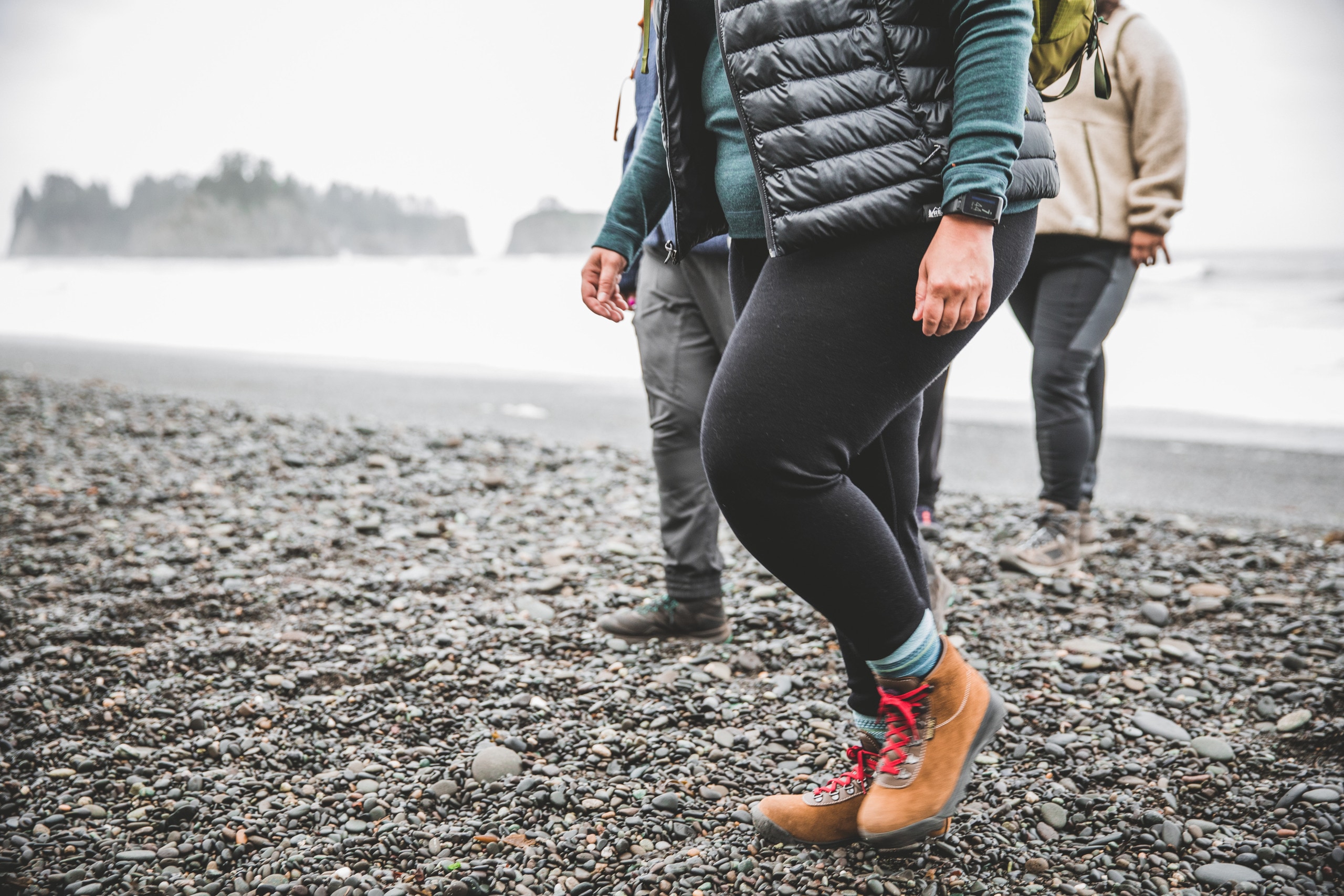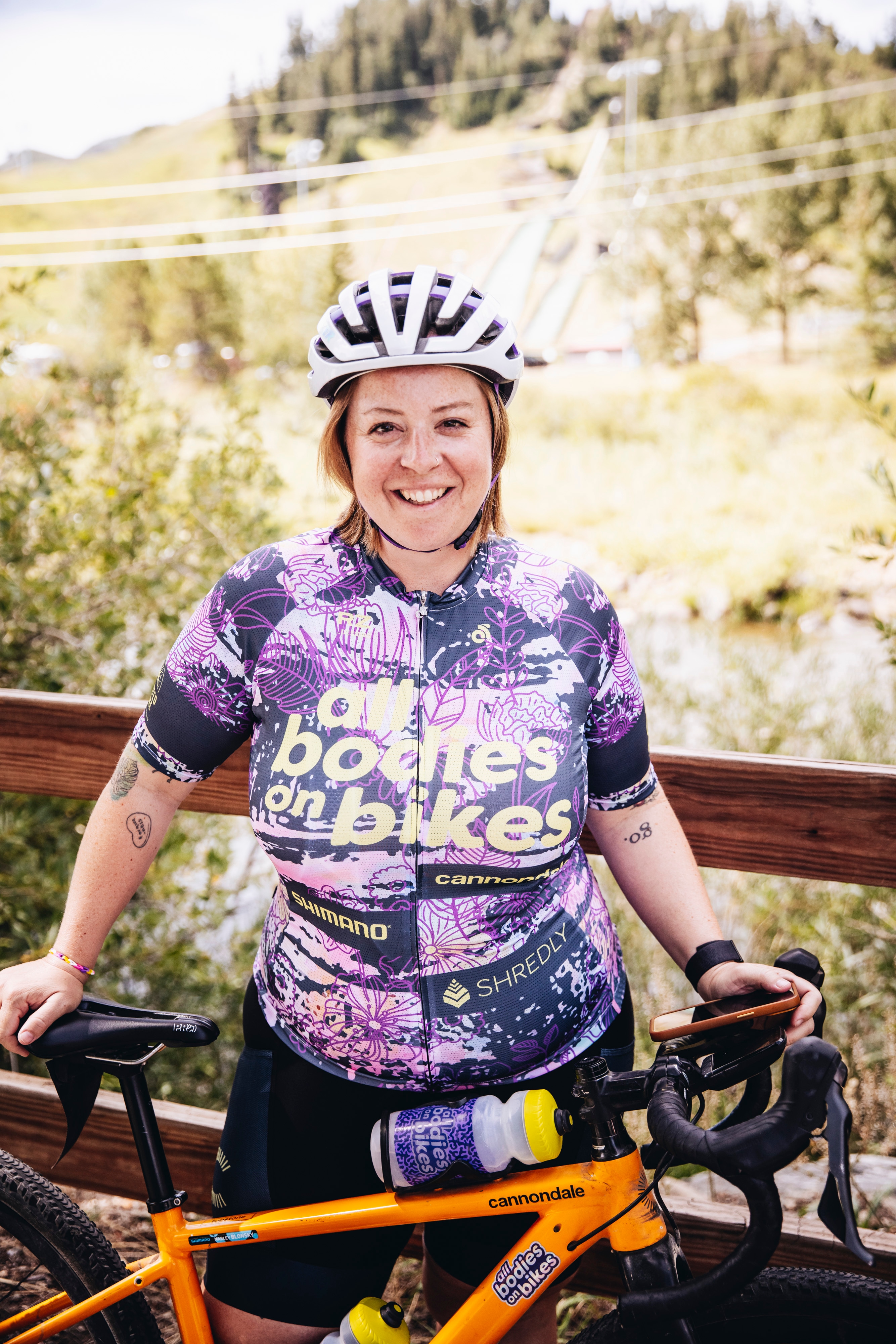Folks of all shapes and sizes hike, climb, bike, paddle and explore the outdoors. But plus-size outdoor enthusiasts often face challenges in finding well-fitting and high-quality gear for their adventures. However, the outdoor industry is slowly improving, with more brands—including REI Co-op—expanding their size ranges and designs specifically for people who identify as plus-size, fat, higher-weight or larger bodied. The outdoors should be accessible to everyone, regardless of size, and creating a wider range of gear and apparel sizing for all body types is key to making that access possible.
It’s important to note that there’s no “right” or “wrong” way to choose apparel and gear for bigger bodies. Just as your body type and preferences differ from others, the shopping experience differs too. However, for this guide, we talked with experts including outdoor clothing designers and merchandisers and REI Co-op staff for general guidance about shopping in the plus-size category.
This article will help you navigate the best options, ensuring you find apparel and equipment that allow you to explore the outdoors with confidence and ease. We will cover the following topics:
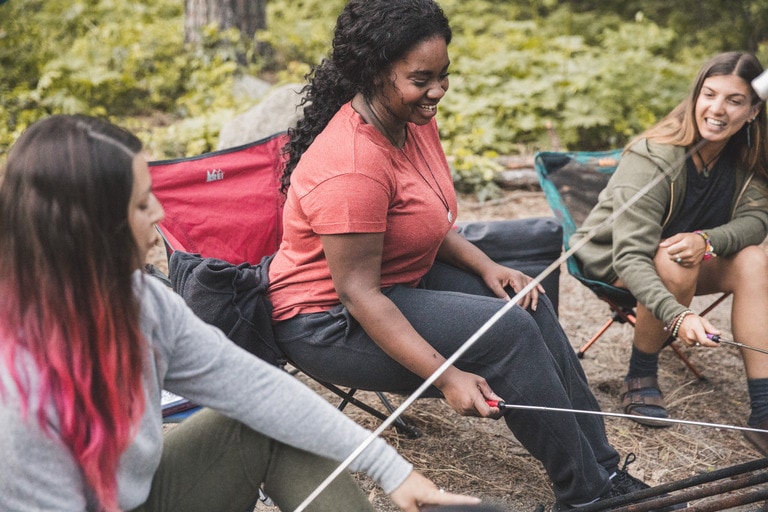
Plus-Size Outdoor Apparel
Shop for Stretch and Durability
Prioritize product materials and fabrics with stretch, breathability and abrasion resistance for outdoor activities. These materials will provide more comfort and durability for higher intensity movement. The stretchiest materials are typically blends that incorporate elastane/spandex, polyester and nylon, for flexibility.
Some of the most common stretch fabric options include:
Spandex, elastane or LYCRA®
Knit fabric (often including a nylon or polyester blend)
Merino wool with added spandex
Materials marketed as “2-way stretch fabric," which can be stretched in two directions, or "4-way stretch fabric" that can be stretched in four directions (more commonly found in swimsuits)
“When reading product descriptions, look for apparel and gear that are abrasion-resistant, moisture-wicking and breathable,” recommends apparel expert and founder of (now closed) plus-size outdoor clothing brand Alpine Parrot, Raquel Vélez. “For example, rubbing within the inner thighs tends to break down [fabric] before anything else, resulting in chafing and a bad experience. So, if you are looking for items you'd be walking around in that have abrasion resistance, that's going to be a better option for folks in bigger bodies.”
Vélez also points out the importance of how the fabric was produced: "Fabrics come in two major categories: woven and knit. Wovens are like a cross-hatch formation, e.g. made on a loom, while knits are made with loops. Knits are inherently stretchy, depending on how loose the loops are. Wovens are not inherently stretchy, which is why threads of elastane (spandex or LYCRA®) are usually added to force a stretchiness to them. Some fabrics are woven in a special way as to have 'mechanical stretch' that avoids the use of elastane."
Tips for Layering
Layering clothing for outdoor adventure not only ensures a comfortable outing, as you can adjust what you’re wearing for the weather and conditions, but it’s also a safety precaution for temperature regulation. The right layering system incorporates three main pieces: a base layer worn close to the skin to wick away sweat and stabilize your core temperature; a mid layer for insulation; and an outer layer to block rain, snow and wind. (Read more: Layering Basics)
By choosing breathable, stretchy and adjustable layers, plus-size adventurers can stay warm, dry and comfortable in all types of conditions. There are several factors to consider when layering clothing as a larger-bodied person.
Stretchy materials: Especially for mid and outer layers, stretchy materials allow for movement underneath a shell or jacket and provide room to move with you instead of constricting you.
Adjustable layers: This can look like windbreakers or raincoats with drawstring hems or hoods, hook-and-loop wrist straps or size zippers. These layers provide a fine-tuned fit like the ability to loosen or tighten as needed.
Breathable layers: Shells, jackets and pants with venting pits or leg zips let you adjust your temperature if you’re prone to overheating. Or, you can zip them closed if you need to conserve heat.
If layering feels restrictive for your body, consider sizing up in outer layers to make more room for clothes underneath. Also, instead of opting for thick, heavy base layers and mid-layers, you can choose thin, high-performance fabrics like merino wool or polyester that help trap heat without adding bulk.
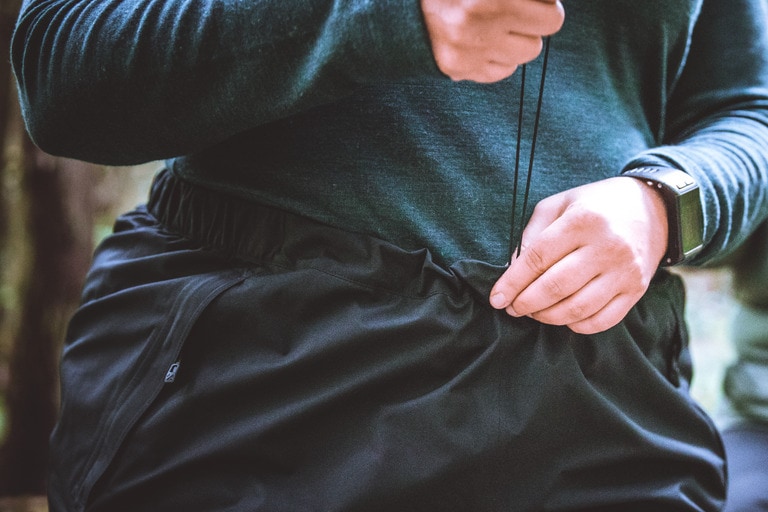
Essential Features for Plus-Size Apparel
Activewear: Shirts, Pants and Shorts
Prioritize freedom of movement when shopping for general activewear—like shirts, pants and shorts—to ensure that clothing doesn’t feel too restrictive. Seek out activewear designed with adjustable waistbands and stretch panels to provide a more customizable fit and comfort while moving your body—no matter its size.
Extended-length shirts, jackets and pants can give you more coverage and prevent exposure while biking, paddling, or even bending and stepping on variable terrain while hiking. Keep an eye out for moisture-wicking fabrics too, which will help keep you dry by pulling sweat away from the skin, and, ultimately, reduce chafing and discomfort.
Base Layers and Mid-Layers
When buying base and mid-layers, plus-size adventurers should focus on fit and fabric to stay warm, dry and comfortable. Look for moisture-wicking, breathable fabrics like merino wool or synthetic blends to keep sweat off your skin and prevent chafing. Avoid cotton, which traps moisture and can cause discomfort by cooling quickly and staying wet longer.
For base layers, a snug but stretchy fit works best for insulation on all body types. Find the balance between too tight and too loose. Flat seams or seamless designs will help reduce irritation when layered, especially for base layers. For mid-layers, choose lightweight but warm options like fleece or down, a natural material like wool, or synthetic insulation. Avoid layers that are too bulky so that there’s enough room for layering without feeling restricted.
Both base layer and mid-layer tops that come in a full-zip option make it easier to regulate body temperature. Longer cut layers provide extra coverage and won’t ride up as easily during intense movement.
Related reading:
Outerwear
Jackets and shells are essential for regulating your temperature and staying warm and dry outdoors. All outerwear should fit comfortably without being too tight or too baggy, so it’s possible to layer adequately in all types of weather and conditions.
Adjustability is also key. Features like articulated sleeves and gusseted underarms help with flexibility, and drawcord hems and hook-and-loop-closure cuffs keep out wind and rain while giving you an adjustable fit. Manage changes in external and internal temperatures by picking a jacket, shell or other outerwear that’s designed with pit zips or mesh vents to keep you from overheating, or with longer hems to add extra coverage when you're on the move.
Related reading:
Footwear
Finding the right footwear is essential for comfort and stability on outdoor adventures. Look for wide-width boots, shoes and sandals if standard sizes tend to feel too tight. Boots and shoes designed with stability features are crucial for preventing injuries, particularly on uneven terrain.
Footwear with a wide base, grippy outsoles and firm midsole cushioning tends to provide the most stable footing. You can also pair your shoes with wool hiking socks to wick away moisture, reduce friction and help prevent blisters, especially on longer treks or adventures.
Related reading:
Plus-Size Outdoor Gear
Finding the right gear for big bodies beyond apparel is also key. From tents and backpacks to hiking poles and climbing harnesses, proper-fitting gear can enhance comfort, safety and your overall experience outdoors.
Here are some things to consider when buying gear for larger body types.
Backpacks with Adjustable and/or Padded Straps and Hipbelts
Look for backpacks with longer shoulder straps, extended hipbelts and adjustable sternum straps. Plus-size-friendly designs help distribute weight properly and can aid in preventing injury while on the trail. Hipbelts with extra padding can help improve back and shoulder comfort while hauling loads, especially on longer trips like thru-hiking or long-distance hiking.
Related reading:
Wide Sleeping Bags and Pads
Choose inclusive-size sleeping bags and sleeping pads that allow for more movement and better coverage while camping. Sleeping bags that come in wide sizes prevent a restrictive fit. Sleeping bag length can also play a factor in comfort. If you’re on the taller side, opt for long sizing when buying a sleeping bag.
You can also opt for a backpacking or camp quilt. Unlike traditional sleeping bags, quilts do not have a back side or zippers, meaning they fit more like an insulated blanket but provide more room to move.
Wider sleeping pads can help keep more of your body off the hard ground and allow you to sprawl more as you sleep.
Related reading:
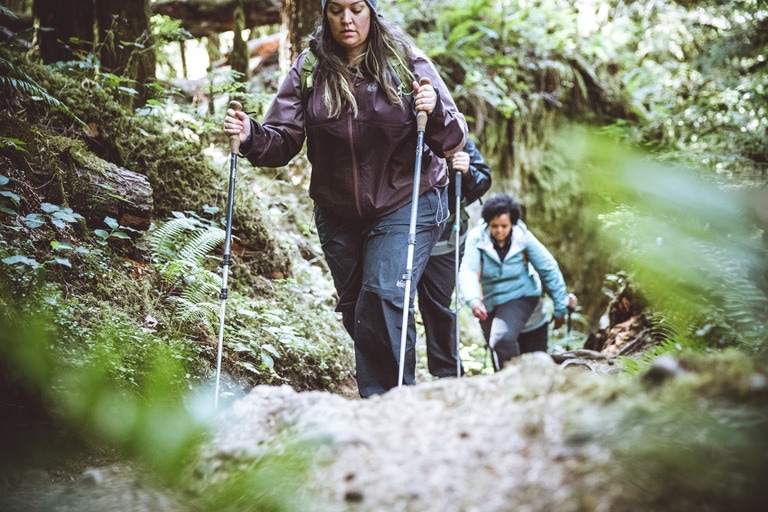
Hiking Poles for Stability and Support
No matter your body shape or size, hiking poles can help reduce unnecessary strain on your knees, hips and back. Buy adjustable and shock-absorbing trekking and hiking poles to reduce strain. Hiking poles also help improve balance by providing extra stability for your body on uneven terrain.
Related reading:
Easy-Access Tents
Seek out a tent with a larger doorframe, taller ceilings and wide floor plan to ensure ease of movement and added sleeping space. A large-footprint tent, like a family or car camping tent, provides ample room for campers of all sizes and extra gear too.
Related reading:
Shopping Tips for Plus-Size Apparel and Gear
Understanding Apparel Sizing
Sizing and fit can be very confusing, as there’s no universal standard for what constitutes "plus-size" across brands. Sizing in general also varies widely between brands, so it’s essential to review size charts, take your measurements, and read customer reviews for accuracy in sizing and fit.
Typical “mainstream sizes” range from 0 to 14 or XS (extra small) to XXL (extra extra large). However, the majority of American women wear sizes that fall above this range, according to Vélez. Extended sizing includes sizes beyond these typical ranges.
Vélez says that while plus sizes are reportedly sizes 14 and up, “unfortunately, less than 20% of outdoor apparel is made in these sizes that cater to the bigger bodies. That’s why it’s important to take the time and energy to learn what your [measurements] are and compare [them] to a brand’s size chart.”
Taking Measurements for Apparel
Sizing scales and fit styles vary widely across brands. This makes it essential to shop by your precise measurements rather than relying on standard size labels (XS to XL).
“My biggest caution for folks is don't worry about the number on the label,” says Marley Blonsky, a fat adventure cyclist, advocate, influencer and cofounder of the inclusive cycling community organization All Bodies on Bikes. “Even if brands have a 2X or 3X, when you look at the measurements, it doesn't actually translate to extended sizing.”
You can take accurate body measurements using a flexible tailor’s tape measure. You can also use a string to take your measurements. Wrap the tape or string snugly around the key areas listed below without pulling too tight. Keep in mind when measuring your hips to wrap the tape measure around the widest point of this area, which may include your bottom or FUPA (fat upper pubic area).
Measure yourself carefully and use the brand's size chart to determine your size. Don't rely on your "usual" size, as there’s variance across brands. “Look at the actual size charts and your body measurements to figure out if the item is going to fit,” says Blonsky.
How to Take Body Measurements
Chest: Wrap the tape measure around your chest at the fullest point, keeping the tape level. Vélez says, "Make sure to take a deep breath as well, so that there's room to breathe!"
Waist: Measure your waist at the narrowest point, without sucking in.
Hips: Standing with your feet together, measure your hips around the widest part.
Inseam: Check your inseam by measuring from your crotch to the bottom of your ankle.
Biceps: Wrap the tape measure around the fullest part of your bicep, typically a few inches beneath your armpit.
Focus On Fit
Brands often use a single form—also called a body mold or model—to create their patterns, which can lead to poor fit for those outside that specific body type. More inclusive brands use multiple models.
Adjustable features and varying closures or details can help when finding the right size:
Elastic or adjustable waistbands: Stretch panels, drawstrings or belt loops provide custom adjustment for more comfort, especially in pants and jackets.
Hook-and-loop closures or snap cuffs: Adjustable sleeve cuffs help prevent wind, rain or cold air from entering and can be tightened to be more snug.
Drawcords: Found on jackets and some shirts, allowing wearers to cinch the waist or bottom hem more securely and for added weather protection.
Articulated knees and gusseted crotches: Designed to provide extra room and flexibility in pants for better movement, especially for hiking or climbing.
Side zippers and expandable panels: Some jackets, vests and base layers include side zippers or stretch inserts to allow more room when layering or for extra comfort.
Adjustable shoulder straps: Useful for backpacks, hiking gear and bib-style pants to prevent discomfort or pressure points.
These features help ensure a more comfortable and functional fit, which can make outdoor activities more enjoyable for plus-size adventurers.
REI Co-op designers have sought to create size-inclusive collections like the Trailmade line, which is available from XS to 3X. When designing products to fit a wider range of body types and sizes, REI designers intentionally choose materials and fabrics that can stretch and adjust with the wearer.
“[With Trailmade], we knew we needed to fit a really wide range of body types, so we focused on making sure that all the materials had some level of stretch,” says Sarah Stephens, lead designer for sportswear and activewear at REI. “That way the pieces would be more comfortable on different bodies."
Advice for Shopping for Plus-Size Apparel and Gear
Set emotional boundaries. Trying on clothes in a store can be an emotionally difficult experience for plus-size shoppers, often leading to frustration when sizes don’t fit properly. “The number of tears that are shed in fitting rooms is far too high—we need to reduce it,” Vélez says. “It can be incredibly alienating and it is an act of courage just to walk into the store in the first place.” Consider how long you want to spend in a store trying items on, as well as how many different sizes or variations of a product you want to test before taking a break. If you shop online, read reviews that indicate how an item fits. Some websites also indicate the model's height and clothing size they're wearing in photos; you can use those to gauge what the fit and drape of an item might be.
Bring a buddy with you. To make the shopping process easier, Vélez recommends going with a trusted friend or family member for moral support. A companion can offer encouragement and make the experience feel less isolating and more positive. By turning the trip into a fun outing, you can celebrate the wins and make shopping feel more enjoyable. Plus, if a sales associate makes an insensitive comment, an ally may be able to help navigate the situation.
Shop with retailers that accept returns. REI Co-op Members get one full year of returns on any item for almost any reason. Even if you shop from home, shopping from brands and retailers with flexible return policies makes it easier to return if items don’t fit quite right.
Choose brands that intentionally design for bigger bodies. Look for brands that offer extended sizing by design. Rather than simply scaling up their sizes, the following brands make apparel and gear using high-quality fabrics, strategic tailoring, appropriate form and fit models, and real customer feedback to inform design styles for larger bodies.
Here are some brands that pay special attention to plus-size designs:
KinsaActive – Women’s plus-size base layers
Miss Mayfly – Women’s fly fishing gear
REI Co-op – Outdoor apparel for all bodies
Shredly – Women’s mountain bike apparel
SuperFit Hero – Women’s activewear
TomboyX – Apparel and swimwear
- Zize Bikes – Bikes for heavy riders
